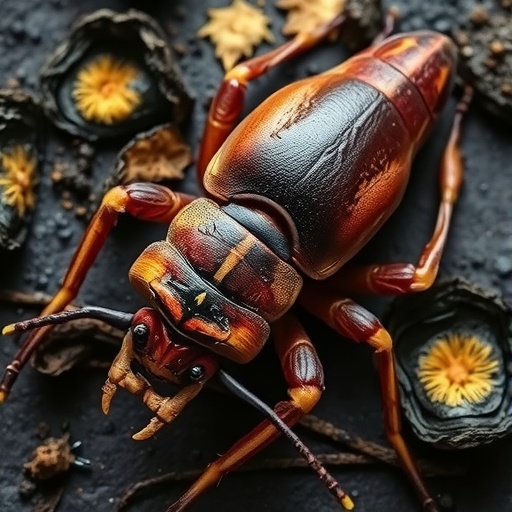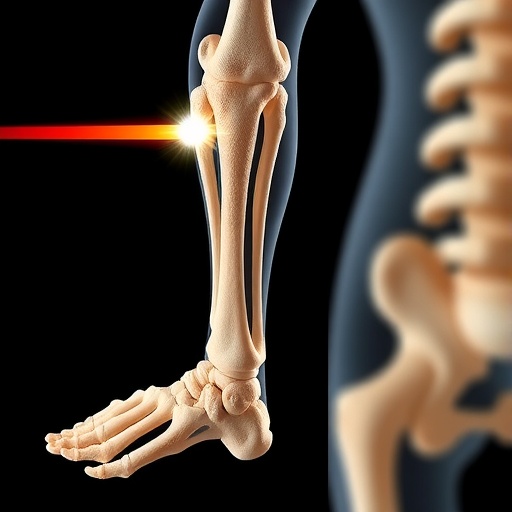In the dense, humid reaches of tropical rainforests, decay is not merely a process of decomposition but a complex biological symphony involving myriad organisms working in concert. A groundbreaking study recently published in the International Journal of Legal Medicine sheds new light on this intricate ecological interplay by examining the communities of insects, bacteria, and fungi associated with Sus scrofa, commonly known as wild boar, carrion in these challenging environments. This research marks a significant step forward in forensic and ecological science, illustrating the multilayered biotic interactions underlying carrion decomposition that can have implications ranging from forensic investigations to biodiversity studies and ecosystem monitoring.
The research delves into the multifaceted biotic assemblages that colonize decomposing animal remains in tropical rainforests — ecosystems characterized by extraordinary species richness and complex microbial dynamics. Tropical rainforests differ markedly from temperate systems, where most carrion decomposition studies have traditionally been conducted, not only in climate but also in the composition and succession of decomposer communities. The warm, moist conditions of tropical rainforests accelerate decay processes and support an astonishing variety of organisms that interact in unique ways, often still poorly understood.
Sus scrofa, or wild boar, was used as the focal substrate for this study owing to its ecological significance and similarity to other mammals often involved in forensic contexts. By carefully monitoring wild boar carcasses placed in a tropical rainforest, the researchers cataloged the succession patterns of insects, bacteria, and fungi, unraveling the temporal and spatial colonization sequences that define the decomposition trajectory. Such pioneering work is crucial because the odyssey of decay in these environments is not a linear process but a dynamic and cyclical exchange of biological agents that influence each other’s activity systematically.
Insects are the most conspicuous agents of decomposition, often dominating initial colonization phases. The study highlights that blowflies (Calliphoridae) are among the first colonizers, their larvae feeding on flesh and facilitating further microbial invasion. However, this research goes beyond identifying mere insect presence — it tracks shifts in insect community composition over time, illustrating how different species succession corresponds to specific decomposition stages. These patterns are essential for forensic entomology, which seeks to estimate postmortem intervals (PMI) with greater accuracy, especially within tropical settings that have historically posed significant challenges due to variable insect activity and diversity.
Parallel to insect colonizers, bacterial communities form a hidden but no less crucial pillar of carrion decomposition. The rainforest microbiome, influenced by temperature, humidity, and initial carcass microbial flora, undergoes rapid successional changes throughout the decay process. Using advanced molecular techniques, the study identifies shifts from aerobic to anaerobic bacterial populations as the carcass moves from fresh to putrefactive stages. These microbial successions not only contribute directly to the breakdown of organic tissues but also modulate the olfactory cues that attract insects and scavengers, thereby integrating microbial activity within the broader biotic network.
Fungi, often overlooked in similar studies, exhibit dynamic roles in this ecological theater as well. The researchers report a distinctive fungal trail that traces later decomposition stages, where fungal mycelia invade carrion tissues and the surrounding soil substrates. This fungal colonization contributes to nutrient recycling and may influence the microbial and insect communities through competitive or symbiotic interactions. The study effectively demonstrates that fungal presence is not simply opportunistic but a regulated component of decomposition ecology in tropical habitats.
Methodologically, the research employed a suite of modern analytical tools — from entomological sampling and morphological identification to high-throughput sequencing of bacterial and fungal DNA. By coupling classical field observations with molecular data, the study achieves unprecedented resolution in tracking the complex biotic assemblages involved. This comprehensive approach allows the disentanglement of multiple overlapping biological processes, providing detailed insights into the rates and pathways of tissue breakdown and nutrient cycling under tropical conditions.
The temporal dimension of the study revealed marked biodiversity shifts aligned with precise decomposition phases. Early colonizers favored by oxygen-rich conditions gave way to anaerobic taxa as putrefaction advanced, with striking shifts in the proportional representation of various insect families and microbial lineages. For instance, dipteran flies dominated the initial stages, while beetles and other insect taxa rose in prominence later, adapting to the progressively altered chemical environment. Similarly, bacterial genera associated with the production of gases and noxious compounds increased before being succeeded by fungal taxa capable of breaking down recalcitrant organic matter.
These findings of community dynamics hold profound implications for forensic science in tropical areas. Accurately estimating postmortem intervals in such ecosystems requires a thorough understanding of both insect and microbial succession patterns. As global forensic databases are often biased toward temperate environments, this study fills a crucial knowledge gap and suggests that integrated analyses of insect, bacterial, and fungal colonizers yield more reliable PMI estimates. This integration could revolutionize forensic protocols in tropical zones where rapid decay and biodiversity complexity have traditionally limited precision.
Beyond forensic applications, the study’s insights also resonate with ecological and conservation science. Carrion acts as a nutrient hotspot, supporting diverse decomposer communities that contribute to soil fertility and trophic web dynamics. Understanding these interrelationships can aid in monitoring ecosystem health, especially in tropical rainforests under threat from deforestation, climate change, and habitat fragmentation. Moreover, documenting novel or poorly studied microbial and fungal taxa associated with carrion broadens biodiversity inventories and may uncover species with unique biochemical capabilities relevant for biotechnology or medicine.
In light of accelerating global environmental changes, studies like this emphasize the importance of basic ecological research in tropical regions — hotspots of both biodiversity and environmental vulnerability. Detangling the web of life that orchestrates decomposition can deepen our appreciation of rainforest complexity while providing tools to better protect these ecosystems. Furthermore, by expanding the forensic toolkit, such research enhances justice avenues in regions where criminal investigations rely heavily on biological evidence under challenging environmental conditions.
The study also prompts new questions regarding the interplay between climate variability and decomposition biomes. For instance, seasonal fluctuations in humidity and temperature could drastically alter the timing and composition of decomposer communities, complicating forensic interpretations. Future research might explore these variables, extending sampling across multiple seasons and geographies to build robust predictive models capable of adapting to climatic nuances. Likewise, investigating how invasive species, land-use changes, or pollution affect carrion ecology could reveal cascading impacts on ecosystem functions.
Crucially, the biodiversity documented in this study entails countless micro-interactions that remain largely cryptic to science. The metabolic pathways employed by bacteria and fungi during decomposition, particularly in nutrient-poor and competitive tropical soils, represent a frontier for microbial ecology. Understanding the chemical dialogues and enzymatic mechanisms underlying tissue degradation could spur innovations in waste management, bioremediation, and synthetic biology, underscoring the applied potential of fundamental decomposition research.
In summarizing this pioneering investigation, it becomes evident that carrion decomposition in tropical rainforests is not simply a terminal event but a dynamic, multifaceted ecological phenomenon involving sophisticated interactions among insects, bacteria, fungi, and the physical environment. The enhanced resolution offered by integrating entomological and molecular microbiological data sets a new standard for future studies. It challenges previous paradigms built on temperate models, demonstrating the unique and fast-paced biological rhythms shaping decomposition in tropical biomes.
As the scientific community embraces more integrative methodologies, the boundary between forensic science, ecology, and microbiology blurs — fostering interdisciplinary collaborations that enrich our understanding of life cycles and biogeochemical flows. This study exemplifies such synergy and its capacity to yield insights that are both intellectually profound and practically relevant. It lays fertile ground for subsequent explorations destined to reframe how we perceive death, decay, and ecological connectivity in some of Earth’s most complex and vital landscapes.
Ultimately, the research underscores the urgency of studying undecomposed biological processes within their natural contexts. Tropical rainforests harbor exceptional biodiversity and serve as windows into ecological intricacy. By illuminating decomposition dynamics in these environments, the study contributes to a growing body of knowledge capable of addressing environmental, forensic, and conservation challenges in an era of unprecedented global change.
Subject of Research: Insect, bacterial, and fungal communities associated with Sus scrofa carrion in a tropical rainforest.
Article Title: A preliminary study of insect, bacterial, and fungal communities associated with Sus scrofa carrion in a tropical rainforest.
Article References:
Zaini, N.A., Ivorra, T., Rosman, N. et al. A preliminary study of insect, bacterial, and fungal communities associated with Sus scrofa carrion in a tropical rainforest. Int J Legal Med (2025). https://doi.org/10.1007/s00414-025-03598-9
Image Credits: AI Generated
Tags: bacterial interactions in decompositionbiodiversity and ecosystem monitoringbiotic interactions in decompositioncarrion ecology in tropical regionsdecomposition processes in humid climatesecological interplay of decomposersforensic implications of carrion studiesfungal life on wild boar carrioninsect communities on carrionmicrobial dynamics in tropical environmentsSus scrofa decay researchtropical rainforest ecosystems





